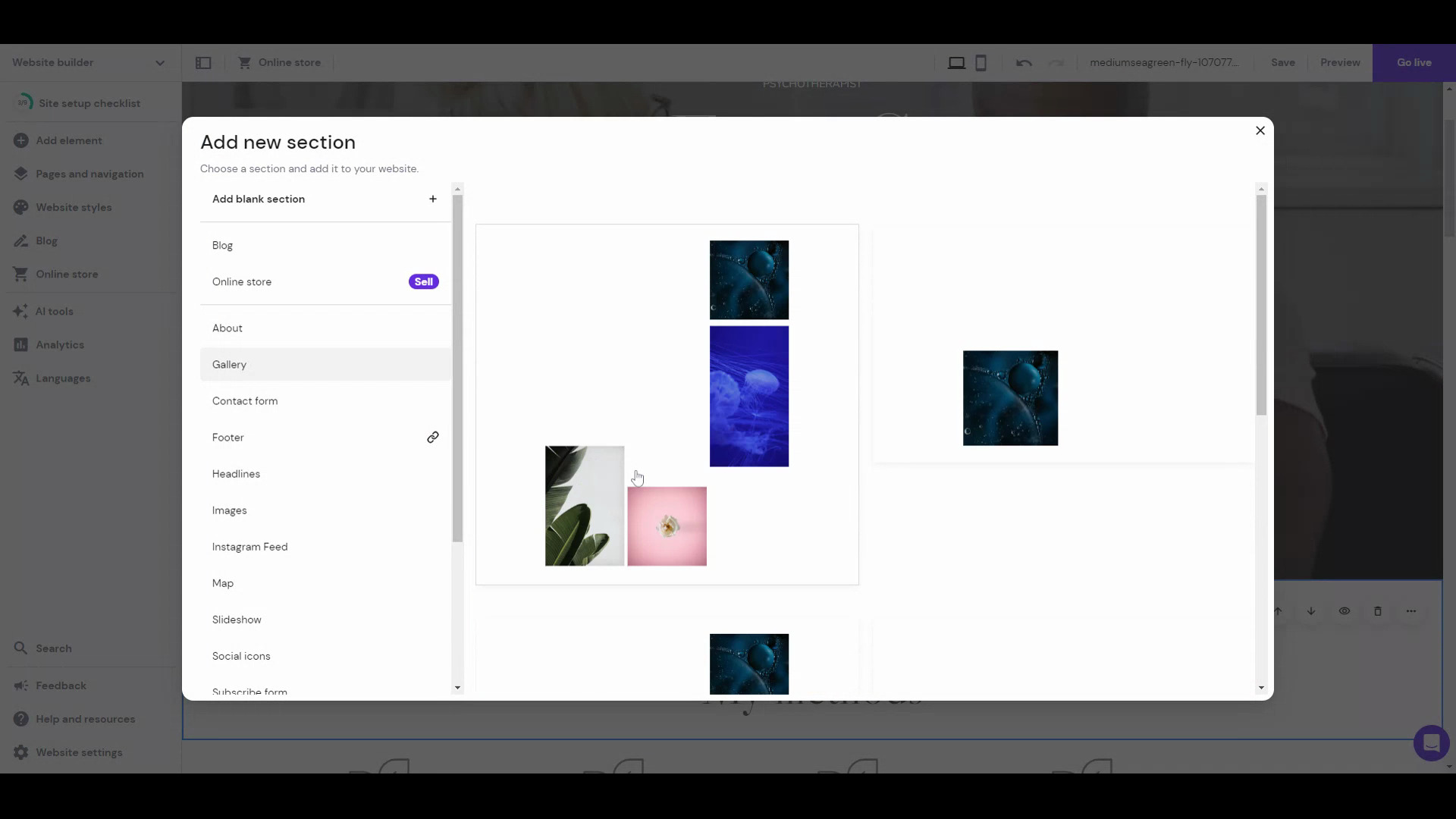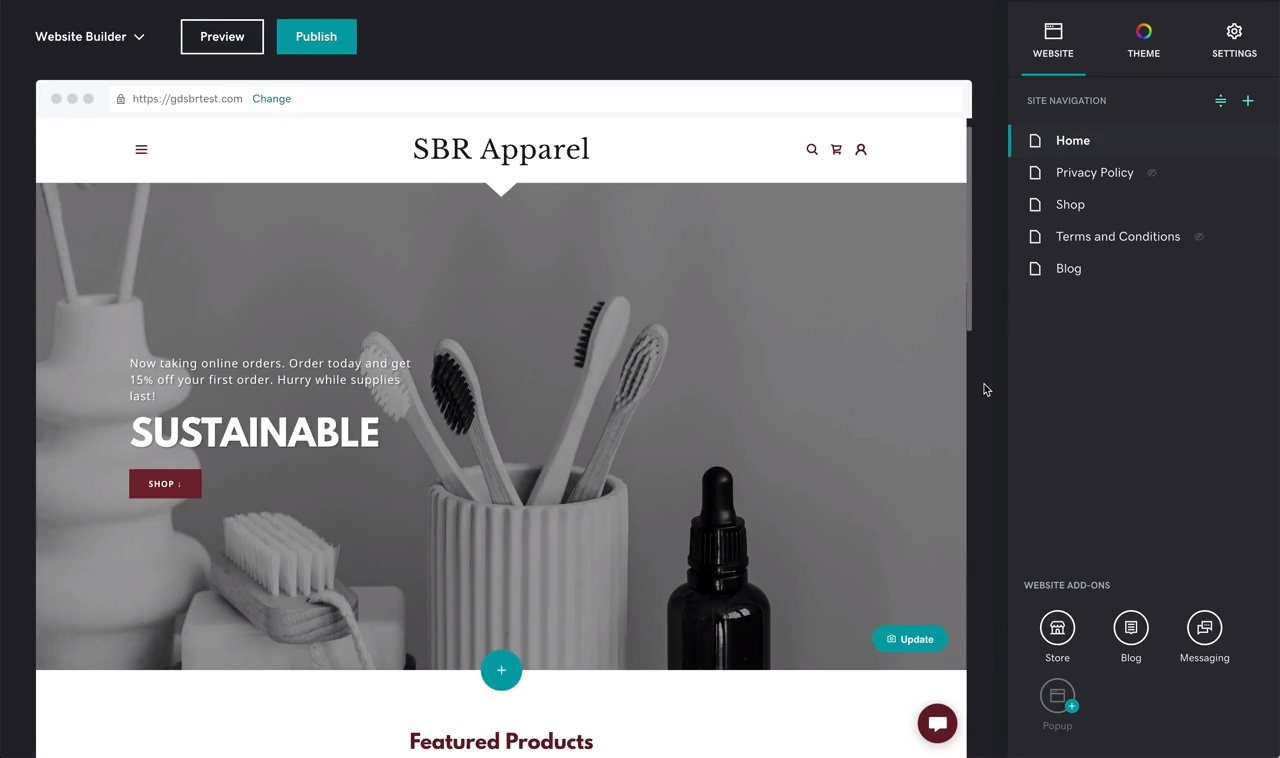Best Website Builder
I test every website builder so you don’t have to. These are my rankings of the best website builders in 2025.
Our work is supported by affiliate commissions. Learn More
By Juhil Mendpara | Updated Jan 3 2025
Don’t choose Weebly in 2025! And if your website is already on Weebly, you know why it’s wise to choose a Weebly alternative.
Once a Site Builder Report favorite, Weebly was acquired by Square in 2018, and it’s been a downhill journey for the product since.
We reviewed Weebly last year and noted several issues, including increasing bug reports, a lack of new features and themes since the Square acquisition, and abandoned forums and social media. We also mentioned how Weebly was asking (almost forcing?) existing users to migrate to Square Online — a completely different website builder.
Things have only gotten worse:
In short, don’t choose Weebly! You are better off with one of these alternatives:

Squarespace Overview (2:41)
Squarespace is the best overall website builder and a direct Weebly competitor from the start.
At its peak in 2018, we rated Weebly 5/5. There was one more website builder with the same rating: Squarespace.
Squarespace has only improved since then and still maintains the 5/5 rating! It’s the best overall website builder, and we recommend it for pretty much all types of websites: businesses, portfolios, churches, weddings, blogs, ecommerce, and more.
It has more (and more refined) features than Weebly, including better templates, better ecommerce (see Squarespace vs Square Online, i.e., Weebly’s ecommerce), better blogging, and better intuitiveness, among other things. It’s also intuitive and easy to use (which is one of the primary reasons people choose/chose Weebly).
Weebly is slightly cheaper than Squarespace, but Squarespace is undoubtedly a superior value-for-money website builder.
Squarespace is known for its clean, modern, and mobile-friendly templates. They have nearly 160 of them—all free, all beautiful. I think Squarespace has the best templates of any DIY website builder— \*\\\[look at them](https://www.sitebuilderreport.com/templates/)\\\*
It’s not just beauty! Squarespace has lots of features—many of which are better and more powerful than competitors. For example, Squarespace has the best template customization, blogging, scheduling software, donation system, photo galleries, restaurant menus, podcasting features, and more. Squarespace also has Squarespace Extensions, a marketplace where you can find a select few third-party extensions to add functionalities to your site.
The new Squarespace editor, Fluid Engine (launched July 2022), lets you drag and drop blocks anywhere in a section. The blocks snap to an underlying grid. It’s much more customizable than its predecessor yet equally intuitive and easy to use. You can also edit the mobile website using the same editor (just switch to mobile view when editing)
Beyond websites, Squarespace also includes marketing and business tools for managing your online presence. For example: scheduling software, email marketing, social media tools, SEO tools, memberships, and more. Having all these tools managed by Squarespace means the integrations work seamlessly.
The most powerful ecommerce website builder is \\\[Shopify](https://www.sitebuilderreport.com/best-ecommerce-builders)— but Squarespace is easier to use. Squarespace’s ecommerce is a good alternative for users intimidated by Shopify and looking to build a small-mid-sized online store. \\\*\\\[Read our Squarespace vs Shopify comparison](https://www.sitebuilderreport.com/squarespace-vs-shopify)\\\*.
Squarespace is like the Apple of website builders—it is intuitive and thoughtfully designed. There’s a certain focus on user experience, even with the tiny things. For example, Squarespace includes a handy tool that lets users adjust the focal point of an image. Another example: Squarespace elevates the page by placing the toolbar below, ensuring you have a full view of the web page when editing.
One way to make software easy to use is to make it simple and not very customizable. That’s not Squarespace. While Squarespace is not “difficult to use”, it does have too many features to be the \\\[“easiest” website builder](https://www.sitebuilderreport.com/easiest-website-builders)— the easiest website builder is \\\[Square Online](https://www.sitebuilderreport.com/best-website-builder#square) which is more simple but also less powerful. You should expect a small learning curve with Squarespace— similar to learning Microsoft Word or Google Docs for the first time.
Squarespace plans start at $16 per month on annual plans. There is no free plan, but they have a free trial—no credit card is required.
The base plan is perfect for non-business/non-ecommerce websites like personal sites, resume websites, portfolio websites, wedding websites, etc. However, you need to choose a Commerce plan otherwise, which starts at $27/month if you pay annually.
All annual plans include a free custom domain name for one year. 👍







Shopify Overview (4:12)
Shopify is the best Weebly/Square Online alternative for serious ecommerce websites.
Weebly’s ecommerce capabilities started with Weebly eCommerce, a proprietary ecommerce platform that launched in 2013. However, after the Square acquisition, Weebly eCommerce was replaced with Square Online.
Both platforms (Weebly eCommerce back then and Square Online now) are decent only for small, simple stores. If you want a full-fledged ecommerce platform, Shopify is the obvious choice.
We don’t have a comprehensive Weebly eCommerce/Square Online vs. Shopify comparison. But we did compare Square Online to Squarespace, where Squarespace was the winner. Similarly, we’ve compared Squarespace and Shopify and Wix, Shopify, and Squarespace, and Shopify is miles ahead.
By extension, here’s how Weebly/Square Online vs Shopify summary comes out:
(It’s a clean sweep as they like to call.)
Ecommerce happens across many different channels today: Facebook, Google, Etsy, TikTok, or even in person through a point of sale system. Shopify is the ecommerce platform that brings these channels together in one place—so you can have one store that sells across all these different platforms.
If there’s specific ecommerce functionality you need, Shopify probably provides it. Shopify includes email marketing, live chat, local delivery route planning, point of sale systems, product reviews, dropshipping, and much more.
The Shopify app store has over 10,000 plugins from third-party developers that you can use to customize your store. For example: <ul> <li>Etsy Integration crossposts your Shopify products to Etsy.</li> <li>One Click Upsell lets you add upsells (like gift wrapping) to your shopping cart.</li> <li>Floating Widgets lets you add banners to your online store.</li> <li>DSers helps you to dropship from AliExpress.</li> </ul>
Shopify is extensible and customizable—so long as you’re a developer or can hire a developer. Want a specific look for your website? You can hire a developer to code a custom template.
The official Shopify Theme Store includes 12 free themes and 129 paid themes—all optimized for performance and ecommerce conversions. However, you can also choose from thousands of themes from a theme marketplace—for example, Theme Forest has over 1,700 Shopify themes available!
Shopify removes many of the obstacles that stand in the way of starting an online store. Here are two examples: Shopify Payments, you don’t need to connect to a 3rd party payment processor because Shopify includes a payment processor called Shopify Payments. But, of course, you can also connect to your own payment processor if you’d like—Shopify allows integration with 100+ third-party payment processors. Shipping Rates & Taxes, Shopify includes smart defaults for shipping rates and taxes (which you can change later). I’ve found the automatic shipping rates to be pretty accurate—though mileage may vary!
It’s not correct to call Shopify easy to use—it’s too powerful to be simple—instead, Shopify is intuitive. Shopify’s interface is always organized and clear. This is really, really nice—especially when you compare Shopify to competitors like WordPress/WooCommerce and Volusion, which have disorganized interfaces.
Shopify has the most comprehensive collection of articles, help docs, and videos to familiarize you with their platform and ecommerce in general. Their community forum has tens of thousands of Q&As that likely answer almost all your questions. And they also offer live chat, email, and phone support if you need additional help. I raised support tickets twice and got helpful answers both times in 2-3 hours.
Shopify claims Shopify Checkout is the best-converting in the world. They partnered with the Big Three management consultancies (McKinsey & Company, Bain & Company, and Boston Consulting Group) to run independent studies. They found Shopify's overall conversion rate outpaces the competition by up to 36% and by an average of 15%.
Shopify has often been at the forefront of ecommerce innovation, whether with the launch of Shopify Payments or their app store. They are also building for AR and VR right now!
Shopify is powerful, but make no mistake, it has a learning curve. It will almost certainly intimidate less tech-savvy users. I’d recommend Squarespace or Square if you want an ecommerce website builder that’s less intimidating.
Shopify does not have a drag and drop editor. Instead, it has a WYSIWYG page editor that works more like editing a Microsoft Word document. It’s not user-friendly. I’d suggest Squarespace or Wix if having stylish content pages or blogging is important to you.
Shopify has three main plans that cost between $29/month and $299/month (paid annually). However, you can try it for free (without a credit card) for three days and pay $1/month for the first three months to test the platform.
Beyond that, there is Shopify Plus (an enterprise plan) and Shopify Starter (a $5 plan that adds Shopify’s ecommerce functionalities to your current non-Shopify site through their Buy Button channel).
One criticism of Shopify is that there are often additional costs beyond the monthly plan. For example: you may need to buy a custom Shopify template or an app from the Shopify app store.
Learn more about all the costs in our detailed Shopify Pricing guide.







Wix Overview (3:27)
Like Squarespace, Wix has been a direct Weebly competitor from the start and a preferred alternative for flexibility. The three were the top-3 website builder by market share for a long time.
Wix is currently the most popular website builder by market share. Its unstructured editor is its most defining feature—it allows you to move any element to any spot on a page. This allows for plenty of freedom.
It will work best for users who want to be able to control everything…and are comfortable with the risks that come with control.
If Squarespace is the Apple of website builders, Wix is the Android//PC equivalent. It has more features, but they are not as detailed or polished; you have more control, but it takes away from intuitiveness and ease of use; there are lots of templates, but the average template is not as good; there are lots of apps, but the integrations are not as seamless.
Wix’s unstructured editor lets you drag and drop elements anywhere you want on a page— without constraint. You can see a \\\video explanation here. Almost no other website builder provides a drag-and-drop interface like this— every other website builder has constraints. \\\[Wix also has two other editors: Wix ADI — a very simple editor that builds your website by asking you questions (it’s sort of like a setup wizard), and Editor X — a complex editor made especially for designers and agencies]
Wix has more features than any website builder: ecommerce, forums, ticket sales, restaurant ordering, music distribution, appointment scheduling, multilingual websites, and more.
Wix offers more themes than most website builders—though the quality is inconsistent. But if that’s not enough, you can also create your own theme from scratch — Wix’s unstructured editor means you can make significant changes to your Wix template.
Wix has an app store and a huge selection of 500+ widgets and plugins to add to your website or ecommerce.
Wix includes several small business and marketing tools for managing online presence: CRM, social posts, SEO, email marketing, live chat, and more.
Unlike the top two on this list, Wix has a free plan. And it is the most featureful \\\free website builder plan. However, there are quite a few limitations regarding bandwidth, ads, storage, etc.
Notice what I did here? Wix’s drag-and-drop editor is listed as both a Pro and a Con. Here’s why: while the unstructured editor gives users freedom, it also introduces bugs and workarounds that can get very frustrating. This is a complicated issue, so I’d suggest you read my \\\Wix review or look at the videos \\\comparing the Wix editor to the Squarespace editor to learn more.
This is a question of tradeoffs. Wix isn’t as difficult to use as Shopify and WordPress, but you should still expect learning Wix to take some time. There are easier website builders out there— but those website builders don’t have as much functionality and freedom as Wix.
A portion of your bandwidth is used up every time a visitor comes to your website. Wix’s cheapest plan (Combo, priced at $16/month for an annual subscription) puts a 2 GB limit on your monthly bandwidth—which is unfortunate. You shouldn’t have to worry about bandwidth in 2025, and every other website builder on this list includes unlimited bandwidth. To put how much 2 GB bandwidth is in perspective, assume Scott Snyder (whose story we featured in the Squarespace section) makes the same 5 MB+ homepage with Wix’s Combo plan. It’d mean the website will reach the bandwidth limit if 400 visitors load the homepage.
In the last quarter of 2023, Wix made some huge plans & pricing changes.
Before the change, Wix had seven plans; the cheapest plan cost $16/month, and the most expensive one was $59/month (annually). It was in a similar range as its biggest competitior, Squarespace. But now…
In 2025, Wix has increased its pricing. The cheapest plan is $17/month, but the most expensive plan, which seems to be the equivalent of the $59/month Business VIP plan, is now $159/month.





Hostinger Website Builder is cheaper yet better than Weebly.
Hostinger’s website builder is an excellent value-for-money proposition, but it’s fairly new and lacks advanced features.
Some history: Hostinger introduced its no-code, drag-and-drop website builder, Zyro, in 2019 (a year after Weebly was acquired by Square). It was a “side hustle” then. But soon after, Hostinger brought it to its main brand and called it Hostinger Website Builder.
Hostinger has managed to bring a lot of good things from the top website builders and make it their own by sticking to their core audience (i.e., the people looking for affordable and beginner-friendly website solutions).
Hostinger Website Builder is among the cheapest website builders, starting at just $2.99/month (for a 1-4 year commitment, renews at $9.99-$6.99/month afterward). And it’s better than many website builders that cost 2x that!
NOTE: See ‘Tricky Pricing’ in Cons section.
This is the biggest plus of the Hostinger Website Builder. The editing experience is a blend of Wix and Squarespace editors—you can choose to use a grid layout like Squarespace, where you can drag and drop elements in a grid; or you can turn the grids off and use it like the unstructured Wix editor wherein you can drop elements anywhere, and they’ll stick there to pixel perfection.
Hostinger offers a selection of 140+ templates across categories like fashion, photography, portfolio, services, etc.
The Hostinger Website Builder falls short compared to platforms like Squarespace and Wix in terms of advanced features. A few examples: you can’t add a comment section to your blog; ecommerce is limited to 500 products; you can’t add a background video; there’s no option for password-protecting certain pages; the templates are basic; the editor blocks and sections are basic: you can’t add multimedia, menu, calendar, etc. On top of that, there’s no app store to extend the builder’s functionality.
The cheaper website builder plans of Hostinger use shared hosting, which isn’t the best for performance, scalability, and security. In comparison, website builders like Squarespace use cloud hosting for all plans, ensuring great performance and uptime no matter the traffic bumps. Hostinger also offers cloud hosting plans, but those start at $9.99/month (renews at $19.99/month).
Hostinger Website Builder always has the $2.99/month “deal” on, which I find is a bit deceptive — they create a false sense of urgency.
Then, the renewal price written on the landing page is $6.99/month, but it only applies if you buy & renew the 4-year plan.
Also, we can never know when they’ll start charging the base price (which gives subpar value for money). It’s important to consider this because it’s a closed system — i.e. if you want to move away from Hostinger Website Builder, you’ll need to create your website from scratch on whatever new platform you choose.
The Hostinger Website Builder landing page mentions only one pricing — $2.99/month (prepaid for 1-4 years, then renews at $6.99/month).
However, you get the website builder with all Hostinger hosting plans. Its web hosting/shared hosting plans start at $1.99/month (renews at $3.99/month), and cloud hosting starts at $9.99/month (renews at $19.99/month).





GoDaddy Website Builder is simpler and easier than Weebly. But we’d recommend Square Online (Weebly’s replacement in a sense) over GoDaddy.
For simple websites (see examples), GoDaddy website builder is one of the easiest website builders. Plus, it also includes a suite of business and marketing tools: ecommerce, appointment scheduling, email marketing, social media management, graphic design, and a simple CRM, making it an overall good choice for a range of websites.
However, it ranks low on the customization front.
GoDaddy has what we call a “block-based editor” compared to Weebly’s “drag and drop editor.” A drag-and-drop website builder offers a visual interface where users can create and customize their websites by simply “dragging” and “dropping” various elements onto a page. On the other hand, a block-based editor lets you make the website by adding blocks and customizing them. [Side Note: Square Online has a block-based editor similar to GoDaddy Website Builder]
It has some MAJOR limitations when it comes to customizing your website, frustrating enough that I’d only recommend it if you was just a very, very simple website.
For example, you can’t add individual elements to a website, and you’re often not able to make simple style customizations.

Godaddy Editor: Adding a section.
GoDaddy pricing is comparable to Weebly — plans start at $9.99 per month and get more expensive for ecommerce plans. It also has free plan, which we don’t recommend – see why in our free website builder rankings.

Webflow Overview (2:47)
Try Webflow if you find Weebly and all other alternatives too constricting.
Webflow is the most customizable website builder on this list. If you can imagine it, you can probably make it with Webflow.
Just be aware: Webflow has a learning curve. So either you need to learn it (which can take days, weeks, or months depending on your technical experience) or hire a professional Webflow developer to make your website.
A popular analogy is that DIY website builders such as Weebly are like Canva, and Webflow is like Photoshop: Anyone can use Canva and create graphics that work for many use cases. But for fully custom graphics/images, advanced photo editing features and manipulation capabilities of Photoshop do a superior job—the caveat is you need to know graphic design and learn Photoshop (it’s not intuitive).
Webflow is basically a user interface for HTML & CSS code. So if you can do something in HTML & CSS, you can do it in Webflow—which means Webflow offers far more customization options than any other website builder!
Webflow is the only website builder with a full CMS. This is powerful! A CMS lets you create custom collections with fields like rich text, images, files, and more. Plus, they’ve \\\Logic, a feature that allows visitors to make submissions to the CMS!
Webflow includes a separate, friendlier interface (called Editor) that you can hand off to clients and teams. They also allow white-label client billing. Webflow also announced Webflow Apps, their plugins/app store, in November 2022—which already has 28 apps for ecommerce, content management, workflows, etc.
Webflow has some of the best Youtube tutorials around. \\\Seriously. This is great because you will need some tutorials to get up and running with Webflow. \\\[Webflow University is the same thing]
You can choose from over 2000 modern, well-designed third-party templates (paid & free) from the \\\Webflow Website Templates marketplace. And most of them are stunning—many even better than Squarespace templates.
Webflow does not shy away from complexity. Understanding the fundamentals of web design (HTML and CSS) will give you a head start. Someone I know took over a month to learn the basics of HTML, CSS, and then Webflow from Webflow University, only to make a website inferior to what you’d be able to make with a simple website builder.
I wouldn’t recommend building an ecommerce store in Webflow right now. Webflow’s ecommerce plans with no transaction fees start at $79. That’s way too expensive—especially compared to Shopify (which starts at $29) and Squarespace (which starts at $27). Also, Shopify is a much more robust ecommerce platform with assumably lower complexity than Webflow—so the only time Webflow ecommerce makes sense is when you want to use its design interface and the store is secondary.
Some essential features are missing from the cheaper plans. For example, CMS isn’t included in the $14/month Basic plan; the first few plans don’t get the best security; the global CDN access is only available from $39/month Business plan; etc.
Webflow has two types of plans:
They also have separate plans for freelancers and agencies offering Webflow services.












